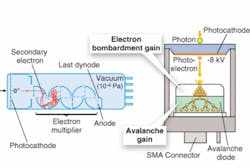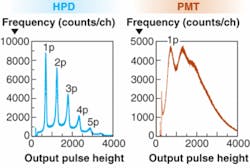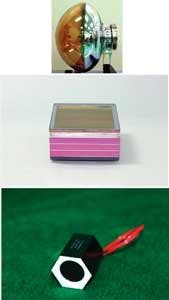PHOTOMULTIPLIERS: Hybrid detector combines PMT and semiconductor-diode technologies
For more than 50 years, photomultiplier tubes have been used as photodetectors for low-light detection. But they are not the only detectors capable of detecting low light. A little-known device—the hybrid photodetector—was developed as an alternative to photomultipliers in particle-physics experiments.1 The hybrid device combines photomultiplier and semiconductor-photodiode technologies.
Technology fusion
While its structure is similar to a conventional photomultiplier, the hybrid photodetector (HPD) also has differences. Like PMTs, the hybrid is a vacuum tube with a photocathode that reacts to light, an electron multiplier that multiplies electrons, and an output terminal that outputs an electrical signal. But whereas PMTs use multiple dynodes as electron multipliers, the HPD uses a silicon avalanche diode (AD) instead. This diode is composed of semiconductor layers: a thin layer of heavily doped p-region that faces the photocathode and is connected to the output terminal, a much thicker silicon substrate in the middle, and a p-n junction connected to a bias terminal (see Fig. 1).
The HPD and PMT have different methods of multiplication. In a PMT, photoelectrons from the photocathode are accelerated by a voltage difference towards the dynodes, where secondary electrons are generated from dynode to dynode, yielding a signal gain of about 106. In an HPD, photoelectrons from the photocathode are accelerated toward the AD by a larger voltage difference (about 8 kV). These photoelectrons are then multiplied in the AD in two steps: electron-bombardment gain, followed by avalanche gain.
In electron-bombardment gain, each photoelectron deposits its kinetic energy in the AD and produces many electron-hole pairs in the silicon substrate. The gain generated in this step depends on the voltage applied to the photocathode—a voltage of—8 kV results in an electron-bombardment gain of about 1600.2 The electrons then drift toward the p-n junction, and avalanche gain occurs.
In avalanche gain, the electrons collide with the crystal lattice of the silicon and create new electron-hole pairs that create more electron-hole pairs in a series of chain reactions. Depending on the reverse-bias voltage applied to the AD, the avalanche gain can range from 10 to 100. The total gain of the HPD is the product of the electron-bombardment and avalanche gains and can be greater than 105.
Characteristics and applications
Although the overall gain of an HPD is lower than that of a photomultiplier tube, the hybrid offers other useful characteristics. These include better pulse height resolution, fast time response and excellent timing resolution, and very low to no afterpulses.
The hybrid produces better pulse height resolution than PMTs because of its very high first gain stage. The first gain stage determines the signal-to-noise ratio of the electron multiplication, which in turn determines the detector’s ability to differentiate between one and multiple photons. In HPDs, the electron bombardment gain for one photoelectron is more than 1000 electrons while the first dynode gain of a PMT is typically only 5 to 10 electrons. The much higher first gain stage gives the HPD a better signal-to-noise ratio and the ability to count multiple photons (see Fig. 2).The hybrid is built for speed. By using a low-capacitance avalanche diode and an electron lens with low transit time spread (TTS), the time response and timing resolution (timing jitter or TTS) for the HPD are in the picosecond range. The rise and fall times for a high-speed version were clocked at less than 400 ps, and the timing resolution for a single photoelectron was about 50 ps FWHM.
An afterpulse is essentially a “false” signal generated within the detector itself. In a PMT, it can be caused by an electron escaping the dynodes and then ionizing the residual gas within the vacuum. If the gas ion hits the photocathode, the photocathode will emit an electron that will then be pulled back within the dynodes and multiplied, creating the afterpulse. In an HPD, however, this type of interaction is minimized because it is extremely difficult for an electron to escape the avalanche diode (where electron multiplication occurs) into the vacuum surrounding the diode.
The HPD is suitable for a variety of applications. Lidar (light detection and ranging) and time-correlated single-photon counting (TCSPC) can benefit from the hybrid’s good time response and timing resolution. The lack of afterpulsing suits applications that require low afterpulse to obtain good instrument response function (IRF), such as fluorescence lifetime measurements by TCSPC. Also, the absence of afterpulsing allows good correlation of signals for fluorescence correlation spectroscopy (FCS). The HPD can be used as a detector for confocal and two-photon microscopes, DNA sequencers, and cytometers. And in communications, an HPD equipped with a frequency up-converter can detect near-infrared single photons, a configuration that has important applications in gigahertz quantum key distribution (QKD) protocol.3, 4, 5 And naturally, the HPD is suitable for its original and intended application, high-energy physics.
High-energy physics
The hybrid photodetector was developed in the 1980s as an alternative to PMTs in particle-physics experiments. Particle physics or high-energy physics involves studying subatomic particles with instruments that can detect, for example, Cherenkov radiation from particles moving faster than light through a particular medium. Detecting Cherenkov radiation requires a photodetector with the ability to detect single photons, a fast response time, good timing resolution, high quantum efficiency (QE), high gain, and resistance to magnetic fields (if used in magnetic fields).
Because the HPD meets these requirements, researchers are currently developing HPDs as next-generation Cherenkov detectors (see Fig. 3). Hiroaki Aihara of Tokyo University (Tokyo, Japan) and colleagues are developing a 13-in.-diameter HPD for possible use in the proposed Hyper Kamiokande, a water Cherenkov detector designed to surpass the Super Kamiokande (Hida, Japan) in size and scope. The Hyper Kamiokande, if built, will have more than 200,000 photodetectors for studying neutrinos.6Another type of HPD is a candidate for an aerogel ring-imaging Cherenkov (RICH) detector that will be used to upgrade a section of the Belle detector at the KEKB collider in Japan (Tsukuba, Japan). The Belle detector is used to study CP-violation effects in particle physics, and the RICH detector needs a photodetector that is position-sensitive, has a large effective area, and is resistant to a 1.5 T magnetic field. Toru Iijima of Nagoya University (Nagoya, Japan) and colleagues developed a 144-channel HPD with four AD chips as a possible photodetector for the RICH detector.7
Gamma-ray astronomy is another high-energy physics application that can benefit from the HPD. Photodetectors for gamma-ray astronomy need a photocathode with high QE and a relatively large effective area, with a gallium arsenide phosphide (GaAsP) photocathode preferred. The maximum size for a GaAsP photocathode in a PMT is 5 mm in diameter because of difficulty in manufacturing. However, because of its simpler structure, fabricating a much larger GaAsP photocathode for an HPD is easier. Masahiro Teshima of the Max-Planck Institute for Physics (Munich, Germany) and colleagues developed an HPD with an 18 mm GaAsP photocathode for use in the second MAGIC (Major Atmospheric Gamma-Imaging Cherenkov; La Palma, Canary Islands) telescope, a powerful tool for ground-based gamma-ray astronomy.8, 9
Fluorescence correlation spectroscopy
Researchers are finding that the HPD can be used in fluorescence correlation spectroscopy (FCS)a technique for studying molecular interactions in solution with a confocal microscope. In FCS, a focused laser beam excites a very small volume of a sample (about 1 femtoliter), and a photodetector monitors the fluorescence (photon-to-photon) over time. A digital correlator calculates the correlation of the arrival times and fits the data with an autocorrelation function to determine diffusion time, which depends on the dynamics of the sample. In experiments with two fluorescent dyes or two detectors, the method is called cross-correlation. For only one fluorescent dye or one detector, the method is called autocorrelation.
In FCS, afterpulsing in the photodetector is a problem since the presence of afterpulses distorts the correlation spectra (see Fig. 4). When PMTs or single-photon-counting silicon avalanche photodiodes (SPAD) are used as detectors for autocorrelation experiments, researchers must compensate for the afterpulses in those detectors. Usually the signal is split between two detectors, and the cross-correlation between the detectors is calculated. However, the use of two detectors to detect one signal complicates the experiment. Two detectors require two channels, increasing costs and decreasing the signal-to-noise ratio per channel.10The HPD performs better than SPAD for FCS and performs better than silicon photomultipliers, in general, for FCS and other fluorescence applications such as two-photon microscopy and in vitro diagnosis.10 The lack of afterpulsing is an advantage for FCS experiments as demonstrated by Xavier Michalet of UCLA (Los Angeles, CA) and colleagues who compared the performance of an HPD and a SPAD. The lack of afterpulse allows the use of one HPD for one-channel FCS—simplifying the experimental setup and lowering costs. Also, the GaAsP photocathode with its high QE helps improve the signal-to-noise ratio.
REFERENCES
1. G. Anzivino et al., Nuclear Instrum. and Methods in Physics Res. Section. A 365(1), 76 (1995).
2. A. Fukasawa et al., Conference Record of IEEE Nuclear Science Symposium 1, 43 (2006).
3. C. Langrock et al., Optics Lett. 30(13), 1725 (2005).
4. H. Takesue et al., Optics Exp. 14(20), 9522 (2006).
5. H. Takesue et al., Nature Photonics 1, 343 (2007).
6. Y. Kawai et al., Nuclear Instrum. and Methods in Physics Res. Section A 579(1), 42 (2007).
7. S. Nishida et al., IEEE Nuclear Science Symp. Conf. N24-110, 1260 (2007).
8. M. Hayashida et al., Nuclear Instrum. and Methods in Physics Res. Section A 572(1), 456 (2007).
9. T. Y. Saito et al., 30th Int’l. Cosmic Ray Conf., July 3-11, 2007, Merida, Yucatan, Mexico.
10. X. Michalet, et al., Proc. SPIE 6862, in press (2008).
About the Author
Maridel Lares
Technical Writer, Hamamatsu
Maridel Lares is a technical writer at Hamamatsu (Bridgewater, NJ).
Motohiro Suyama
Manager, R&D group, Electron Tube Division, Hamamatsu
Motohiro Suyama is a manager in the R&D group of the Electron Tube Division at Hamamatsu Photonics in Japan.



